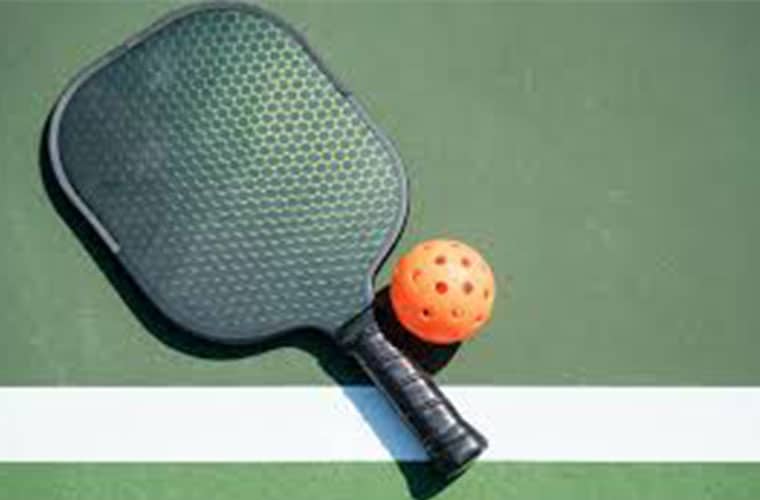In case you didn’t know we recently installed pickleball courts to offer our guests more opportunities for family fun and enjoyment. Pickleball was created in 1965 on Bainbridge Island, a quick ferry ride from Seattle, Washington. Three dads – Joel Pritchard, Bill Bell, and Barney McCallum — whose children were bored with their usual summertime activities — are credited for creating game. Pickleball has evolved from original handmade equipment and simple rules into a popular sport throughout the US and Canada. The game is also growing internationally, with many European and Asian countries adding courts. Click to read the complete history of pickleball.
Rules of Pickleball
The following is an abbreviated form of the rules to give a quick overview of how the game is played. Click Here to see the official rules. If there is a conflict between this summary and the official rules, the official rules prevail.
Basic Rules Overview
-
- Pickleball is played either as doubles (two players per team) or singles; doubles is most common
- The same size playing area and rules are used for both singles and doubles
The Serve
-
- The serve must be made underhand.
- Paddle contact with the ball must be below the server’s waist (navel level).
- The serve is initiated with at least one foot behind the baseline; neither foot may contact the baseline or court until after the ball is struck.
- The serve is made diagonally crosscourt and must land within the confines of the opposite diagonal court.
- Only one serve attempt is allowed, except in the event of a let (the ball touches the net on the serve and lands on the proper service court; let serves are replayed).
Service Sequence
- Both players on the serving doubles team have the opportunity to serve and score points until they commit a fault *(except for the first service sequence of each new game).
- The first serve of each side-out is made from the right/even court.
- If a point is scored, the server switches sides and the server initiates the next serve from the left/odd court.
- As subsequent points are scored, the server continues switching back and forth until a fault is committed and the first server loses the serve.
- When the first server loses the serve the partner then serves from their correct side of the court (except for the first service sequence of the game*).
- The second server continues serving until his team commits a fault and loses the serve to the opposing team.
- Once the service goes to the opposition (at side out), the first serve is from the right/even court and both players on that team have the opportunity to serve and score points until their team commits two faults.
- In singles the server serves from the right/even court when his or her score is even and from the left/odd when the score is odd.
*At the beginning of each new game only one partner on the serving team has the opportunity to serve before faulting, after which the service passes to the receiving team.
Scoring
-
- Points are scored only by the serving team.
- Games are normally played to 11 points, win by 2.
- Tournament games may be to 15 or 21, win by 2.
- When the serving team’s score is even (0, 2, 4, 6, 8, 10) the player who was the first server in the game for that team will be in the right/even court when serving or receiving; when odd (1, 3, 5, 7, 9) that player will be in the left/odd court when serving or receiving.
Two-Bounce Rule
-
- When the ball is served, the receiving team must let it bounce before returning, and then the serving team must let it bounce before returning, thus two bounces.
- After the ball has bounced once in each team’s court, both teams may either volley the ball (hit the ball before it bounces) or play it off a bounce (ground stroke).
- The two-bounce rule eliminates the serve and volley advantage and extends rallies.
Non-Volley Zone
-
- The non-volley zone is the court area within 7 feet on both sides of the net.
- Volleying is prohibited within the non-volley zone. This rule prevents players from executing smashes from a position within the zone.
- It is a fault if, when volleying a ball, the player steps on the non-volley zone, including the line and/or when the player’s momentum causes them or anything they are wearing or carrying to touch the non-volley zone including the associated lines.
- It is a fault if, after volleying, a player is carried by momentum into or touches the non-volley zone, even if the volleyed ball is declared dead before this happens.
- A player may legally be in the non-volley zone any time other than when volleying a ball.
- The non-volley zone is commonly referred to as “the kitchen.”
Line Calls
-
- A ball contacting any line, except the non-volley zone line on a serve, is considered “in.”
- A serve contacting the non-volley zone line is short and a fault.
Faults
- A fault is any action that stops play because of a rule violation.
- A fault by the receiving team results in a point for the serving team.
- A fault by the serving team results in the server’s loss of serve or side out.
Determining Serving Team
Any fair method can be used to determine which player or team has first choice of side, service, or receive. (Example: Write a 1 or 2 on
the back of the score sheet.)
If you are searching best campground near me in Connecticut or New England. If have come to the right place. Acorn Acres Campground is your best spot for family fun.





